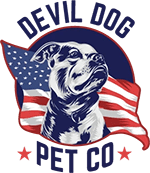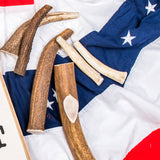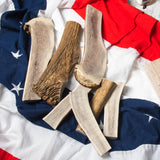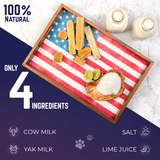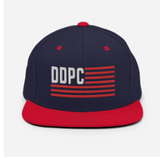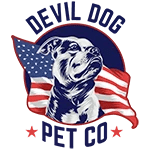Why Safe Chews Matter: The Mission Behind Every Choice
Every time you hand your dog a chew, you're making a leadership decision. Not just about what keeps them busy for an hour-but about their long-term health, safety, and your role as their advocate. At Devil Dog Pet Co., we've seen too many preventable emergencies: dogs rushed to emergency vets with intestinal blockages from rawhide, cracked teeth from poorly sourced bones, and behavioral issues that could've been managed with the right chewing outlet.
Key Takeaways
- Choosing safe chews for your dog is a critical decision that impacts their long-term health and safety.
- Unsafe chews can lead to serious emergencies like intestinal blockages and cracked teeth.
- Proper chew choices can help manage behavioral issues in dogs.
- Devil Dog Pet Co. emphasizes the importance of being a responsible advocate for your dog's well-being.
Table of Contents
- Why Safe Chews Matter: The Mission Behind Every Choice
- What Are "Safe Chews" for Dogs? Definition & Core Standards
- The Health Benefits of Responsible Chewing
- Dog Chew Safety 101: Know & Match Your Dog
- Types of Safe Chews for Dogs: Comprehensive Comparison
- How to Choose the Right Safe Chew for Your Dog
- Supervision & Safety Protocols
- Problem-Solving: Common Chew Challenges & Solutions
- Final Recommendations by Dog Type
- The Devil Dog Commitment to Safe Chewing
- Conclusion: Lead with Confidence, Chew with Purpose
Here's the unfiltered truth: unsafe chews aren't just "bad luck"-they're a leadership failure you can eliminate. When you choose safe chews for dogs, you're practicing Extreme Dog Leadership by taking 100% accountability for your dog's mental stimulation, dental health, and physical safety. Every chew becomes a tool for preventing destructive behaviors, reducing anxiety, and keeping dogs in their forever homes instead of surrendered to shelters.
The Devil Dog Mission: Fewer dogs in shelters, more thriving in homes where owners lead with discipline, knowledge, and the right gear. Safe chews are foundational to that mission.
This isn't about being overprotective-it's about being informed. The difference between a safe chew and a dangerous one often comes down to sourcing, sizing, and supervision. Master those three elements, and you transform chew time from a potential hazard into a powerful training and enrichment tool.
What Are "Safe Chews" for Dogs? Definition & Core Standards

A safe chew for dogs delivers physical, mental, and dental enrichment without compromising your dog's health or safety. It's that simple-and that demanding. Not every product marketed as a "dog chew" meets this standard, which is why you need clear criteria to separate the wheat from the chaff.
The Non-Negotiable Safety Standards
Every safe chew must pass these five checkpoints before it earns a place in your dog's routine:
- Non-toxic materials: Zero artificial dyes, chemical bleaches, or unsafe preservatives. Natural processing only.
- Proper digestibility: Either wears down safely through grinding or is fully digestible if swallowed in appropriate pieces.
- Correct sizing: Cannot be swallowed whole and won't fit between your dog's back molars-always size up, never down.
- Non-splintering structure: Quality chews wear down gradually rather than breaking into sharp, dangerous fragments.
- Transparent sourcing: Clear origin story, ethical supply chain, and rigorous quality control from source to your door.
The Thumbnail Test: Press your thumbnail into any chew. If it doesn't leave even a slight dent, it may be too hard for your dog's teeth. This quick field test can prevent costly dental emergencies.
Unsafe Chews: What to Always Avoid
These materials and features are automatic disqualifiers, regardless of marketing claims:
- Rawhide: Chemically processed, poorly digestible, high blockage risk
- Cooked bones: Prone to splintering and causing internal punctures
- Plastic or nylon bones: Non-digestible and can break into sharp pieces
- Chemically preserved products: Bleached, dyed, or treated with harsh preservatives
- Undersized chews: Anything that fits entirely in your dog's mouth becomes a choking hazard
The goal isn't to eliminate all risk-it's to make informed choices that maximize benefit while minimizing danger. A properly selected and supervised safe chew becomes a tool for building the disciplined, well-adjusted dog every owner wants.
The Health Benefits of Responsible Chewing
When you provide safe chews for dogs, you're not just keeping them occupied-you're actively supporting their physical and mental health. Responsible chewing addresses three critical areas that every dog owner must manage: dental hygiene, mental stimulation, and anxiety relief.
Dental Health: Nature's Toothbrush
Proper chewing acts like a natural dental cleaning system. As dogs gnaw and grind, the mechanical action scrapes away soft plaque before it hardens into tartar. The increased saliva production during extended chew sessions helps neutralize harmful bacteria and wash away food particles.
Research from veterinary dental specialists shows that regular chewing can reduce plaque accumulation by up to 70% when combined with proper dental care. The key is choosing chews with the right texture-firm enough to provide cleaning action but not so hard they risk dental damage.
Mental Enrichment: Satisfying Natural Drives
Every dog has an innate need to chew, rooted in their evolutionary history as hunters and scavengers. When this drive goes unmet, it redirects toward your furniture, shoes, and anything else within reach. Safe chews provide a sanctioned outlet that prevents destructive behaviors while engaging your dog's problem-solving instincts.
Marine Corps Leadership Principle: "Give your Marines something to do, or they'll find something to do." The same applies to dogs-provide structured chewing opportunities, or they'll create their own.
Anxiety Management: The Calming Power of Focus
Extended chewing sessions trigger the release of endorphins, creating a natural calming effect that helps anxious dogs self-regulate. This makes quality chews invaluable tools for managing separation anxiety, thunderstorm fears, and general stress responses.
The rhythmic, repetitive nature of chewing activates the parasympathetic nervous system-the same mechanism that helps humans relax through meditation or deep breathing. For high-drive dogs or those dealing with environmental stressors, a properly timed chew session can mean the difference between chaos and calm.
Dog Chew Safety 101: Know & Match Your Dog

Not every safe chew works for every dog. Successful chew selection requires honest assessment of your dog's individual characteristics, chewing style, and physical capabilities. This isn't about finding the "best" chew-it's about finding the right chew for your specific teammate.
Assess Your Dog's Chewing Style
Dogs fall into distinct chewing categories, and recognizing your dog's style is the first step toward safe selection:
- Power Chewers (Aggressive)
- Bite down with full jaw force, often trying to crack or break chews in half. These dogs need the most durable options and careful supervision to prevent dental damage.
- Moderate Chewers
- Gnaw and scrape methodically, working chews down gradually over multiple sessions. Most chews work well for this group when properly sized.
- Gentle Chewers (Nibblers)
- Lick, scrape, and nibble rather than applying serious bite pressure. These dogs can use softer chews but may need flavor incentives to maintain interest.
Age significantly impacts chewing capability. Puppies need softer options until their adult teeth fully develop around 6 months. Senior dogs may require gentler chews due to dental wear or sensitivity. Adult dogs in their prime can typically handle the full range of safe chews when properly supervised.
Understand Common Chew Risks
Even safe chews carry risks when improperly selected or supervised. Understanding these risks helps you make informed decisions and recognize problems before they become emergencies:
Choking and Blockages: Occur when dogs attempt to swallow pieces too large for safe passage. Always size chews larger than your dog's mouth and remove small end pieces.
Dental Injuries: Result from chews that are too hard for your dog's bite style or dental health. The thumbnail test and gradual introduction help prevent these injuries.
Digestive Upset: Can happen when dogs consume rich chews too quickly or in large quantities. Start with short sessions and monitor your dog's response.
Key Rules for Safe Chew Time
These non-negotiable rules apply regardless of which safe chew you choose:
- Size up aggressively: Chews must be longer than your dog's lower jaw and too thick to fit between back molars
- Supervise constantly: Never leave dogs unattended with any chew-leadership means staying present
- Retire early: Remove chews when they become small enough to swallow or show cracks and sharp edges
- Monitor dental health: Watch for excessive wear, chips, or gum irritation during and after chew sessions
- Start gradually: Introduce new chews with short, supervised sessions to assess tolerance
These rules might seem restrictive, but they're the foundation of responsible chew management. Master them, and you transform potentially dangerous situations into safe, beneficial enrichment opportunities that strengthen your leadership and your dog's well-being.
Types of Safe Chews for Dogs: Comprehensive Comparison
The safe chew market offers distinct categories, each with specific benefits and limitations. Understanding these differences helps you make tactical decisions based on your dog's individual needs, chewing style, and health considerations.
| Chew Type | Durability | Digestibility | Dental Benefit | Odor Level | Mess Factor | Best For | Key Limitations |
|---|---|---|---|---|---|---|---|
| Whole Elk Antler | Maximum (weeks to months) | Minimal (dust only) | Excellent | None | None | Power chewers, long-term value | Too hard for some dogs, tooth risk |
| Split Elk Antler | High (1-3 weeks) | Low (marrow digestible) | Excellent | None | Minimal crumbs | Puppies, seniors, picky dogs | Shorter lifespan, rich marrow |
| Himalayan Yak Chew | High (1-2 weeks) | Complete | Good | Minimal | None | Moderate chewers, allergies | Can be hard for tiny puppies |
| Bully Stick | Medium (20-60 minutes) | Complete | Moderate | Low to moderate | Minimal | Flavor-motivated dogs | Quick consumption, choking risk |
| Beef Tendon | Medium (30-90 minutes) | Complete | Good | Low | Low | Joint health support | Faster consumption rate |
| Fish Skin Chews | Low to medium | Complete | Moderate | Strong fishy scent | Moderate | Omega-3 needs, allergies | Strong odor, limited appeal |
| Verdict | Winner depends on priorities: Whole antlers for maximum durability, yak chews for balanced performance, bully sticks for flavor motivation. Rotate multiple types for comprehensive benefits. | ||||||
Whole Elk Antler Chews: Maximum Durability
Naturally shed Rocky Mountain elk antlers represent the gold standard for power chewers seeking maximum longevity. These dense bone structures force dogs to grind slowly, creating extended enrichment sessions that can last weeks or months depending on chewing intensity.
Pros
- Exceptional durability - outlasts dozens of other chews
- Zero odor and mess - perfect for indoor use
- Hypoallergenic and virtually calorie-free
- Superior plaque removal through mechanical scraping
- Sustainable sourcing from naturally shed antlers
Cons
- Extremely hard - can crack teeth in aggressive biters
- No immediate flavor reward for picky dogs
- Requires careful sizing and supervision
- Higher upfront cost (offset by longevity)
The key to antler safety lies in matching hardness to your dog's bite style. Dogs who gnaw and scrape do excellent with whole antlers. Dogs who bite straight down with full force may need softer alternatives to prevent dental damage.
Split Antler Chews: Gateway to Hardcore Chewing
Split antlers expose nutrient-rich marrow while maintaining the structural benefits of antler chewing. This combination makes them ideal for dogs transitioning to harder chews or those needing immediate flavor motivation.
Best Practice: Start new dogs with split antlers to assess their chewing style and tolerance before graduating to whole antlers.
The exposed marrow provides instant gratification that hooks reluctant chewers, while the outer antler wall delivers the same dental benefits as whole antlers. Monitor rich marrow intake for dogs with sensitive stomachs, and expect shorter lifespan compared to whole antlers.
Himalayan Yak Chews: Balanced Performance
Traditional Himalayan yak chews offer the sweet spot between durability and digestibility. Made from yak and cow milk using centuries-old techniques, these chews provide substantial chew time while remaining completely edible.
The slow-drying process removes virtually all lactose, making these chews safe for most dairy-sensitive dogs. When dogs work down to the final nub, you can microwave it into a crunchy puff for zero waste.
Sizing Strategy: Moderate chewers should size up 1-2 levels with yak chews to maximize value and safety. These chews soften slightly with saliva, making proper sizing critical.
Bully Sticks: Flavor-Driven Engagement
Single-ingredient beef pizzle provides the meatiest flavor profile among safe chews, making bully sticks invaluable for food-motivated dogs and training applications. Complete digestibility eliminates blockage concerns when properly supervised.
Standard bully sticks work well for most dogs, while braided versions provide extended chew time for stronger jaws. The main limitation is rapid consumption - a power chewer can demolish a standard stick in 20 minutes.
Pro Tip: Freeze bully sticks between sessions to increase hardness and extend chew time. Use bully stick holders to manage the choking-hazard end piece safely.
How to Choose the Right Safe Chew for Your Dog

Successful chew selection follows a systematic approach that considers your dog's individual characteristics, safety requirements, and enrichment goals. This isn't guesswork - it's tactical decision-making based on observable data about your dog's behavior and physical capabilities.
The Five-Step Selection Process
- Assess chewing style and dental health: Observe how your dog approaches current chews. Do they gnaw methodically or try to crack things in half? Any history of dental work or sensitivity?
- Measure and size properly: Measure your dog's muzzle length and jaw gap. The chew must be longer than the lower jaw and too thick to fit between back molars.
- Match material to skill level: Power chewers need maximum durability (whole antlers, monster yak chews). Gentle chewers can use softer options (split antlers, standard bully sticks).
- Consider special needs: Food allergies, weight management, or anxiety issues may dictate specific chew types or limit certain options.
- Plan rotation and observation: No single chew meets all needs. Rotate between types to prevent overuse and maintain engagement while monitoring your dog's response.
Recommendations by Chewer Type
- Power Chewers (Aggressive Biters)
- Monster or Beast whole elk antlers, Monster yak chews, braided jumbo bully sticks. These dogs need maximum durability and careful supervision to prevent dental damage from excessive force.
- Moderate Chewers (Methodical Gnawers)
- Large to XL whole or split antlers, Large to XL yak chews, standard to jumbo bully sticks. Most options work well when properly sized - focus on value and variety.
- Gentle Chewers (Lickers and Nibblers)
- Split antlers with marrow exposure, yak chews (can be softened with water), standard bully sticks with flavor appeal. May need encouragement through scent activation or shorter initial sessions.
- Puppies (Under 6 Months)
- Oversized split antlers for supervised sessions, large yak chews, standard bully sticks with holders. Focus on appropriate sizing and gradual introduction to prevent overwhelm.
- Senior Dogs (7+ Years)
- Split antlers, yak chews (can be softened), beef tendons for gentler chewing. Consider dental health and adjust hardness accordingly.
Special Considerations Guide
Food Allergies: Beef allergies → antlers or yak chews. Dairy sensitivities → antlers or bully sticks. Fish allergies → avoid fish skin chews.
Weight Management: Choose low-calorie options like antlers (virtually calorie-free) or limit high-protein chews like bully sticks to occasional treats.
Anxiety Support: Longer-lasting chews (antlers, yak chews) provide extended calming sessions. Avoid quick-consumption options that may increase frustration.
Multi-Dog Households: Separate dogs during chew time to prevent resource guarding. Size all chews for the largest dog to prevent theft and choking hazards.
Remember that individual dogs may not fit perfectly into these categories. Our dog Dexter started as a moderate chewer but became more aggressive as he matured, requiring us to upsize his antlers and adjust supervision accordingly. Stay flexible and adjust based on your dog's evolving needs and responses.
Supervision & Safety Protocols
Even the safest chews require active leadership and proper supervision to prevent emergencies. These protocols aren't suggestions - they're non-negotiable safety standards that separate responsible dog ownership from preventable disasters.
Introducing New Chews Safely
Every new chew introduction follows the same disciplined approach, regardless of your dog's experience level:
Start with 10-15 minute supervised sessions. This allows you to observe your dog's chewing style, check for digestive sensitivity, and ensure proper sizing before extending session length.
During initial sessions, watch for signs of digestive upset, excessive drooling, or attempts to swallow large pieces. Dogs with sensitive stomachs may show loose stools after rich chews like marrow-filled split antlers or high-protein bully sticks.
Gradually increase session length as your dog demonstrates appropriate chewing behavior and tolerance. Most dogs can work up to 30-45 minute sessions with durable chews like antlers or yak chews within a week of proper introduction.
Active Supervision Checklist
Supervision means staying present and engaged, not just being in the same room. Use this checklist during every chew session:
- Position yourself: Stay within arm's reach, especially during the first few sessions with any new chew
- Monitor chewing technique: Reward calm gnawing, redirect aggressive biting or attempts to crack the chew
- Watch the size: Remove chews when they become small enough to swallow or fit between back molars
- Check for changes: Look for cracks, sharp edges, or pieces breaking off that could create hazards
- Observe your dog: Watch for signs of fatigue, frustration, or attempts to gulp rather than chew
The 80% Rule: Remove any chew when it reaches 80% consumed or shows significant wear. This prevents the dangerous final phase when dogs often try to swallow remaining pieces.
Emergency Recognition & Response
Recognizing chew-related emergencies early can mean the difference between a minor scare and a life-threatening situation. Know these warning signs and responses:
Choking signs: Pawing at mouth, excessive drooling, difficulty breathing, blue gums. Response: Open mouth, remove visible objects with fingers or pliers, seek immediate veterinary care.
Intestinal blockage signs: Vomiting, loss of appetite, lethargy, straining to defecate, abdominal pain. Response: Stop all food, contact veterinarian immediately, prepare for potential emergency surgery.
Dental injury signs: Blood on chew, reluctance to eat, pawing at face, visible tooth damage. Response: Remove chew, rinse mouth gently, schedule veterinary dental examination.
These protocols might seem excessive until you need them. The few minutes spent on proper supervision and safety measures can prevent thousands in emergency veterinary bills and, more importantly, protect your dog from preventable suffering.
Problem-Solving: Common Chew Challenges & Solutions
Real-world chew problems require tactical solutions based on understanding your dog's behavior and motivations. These aren't theoretical scenarios - they're the most common issues Devil Dog Pet Co. customers face, with battle-tested fixes that work.
Challenge: Dog Refuses Safe Chews
When your dog ignores premium chews in favor of your furniture, the problem isn't the chew - it's presentation and motivation. Dogs often reject unfamiliar textures or scents, especially if they're accustomed to artificially flavored treats.
Solution: Activate the chew's natural appeal through scent enhancement. Rub a small amount of low-sodium bone broth or natural peanut butter on the surface, then let your dog investigate while you hold one end. This creates positive association and overcomes initial hesitation.
For split antlers, the exposed marrow usually provides immediate interest. With whole antlers or yak chews, try soaking the end in warm water for 5 minutes to release natural scents. Never force the interaction - let curiosity and positive reinforcement do the work.
Challenge: Dog Tries to Swallow Large Pieces
Gulping behavior indicates either incorrect sizing or resource guarding instincts. Dogs who try to swallow large chunks are typically either anxious about losing their chew or working with a piece that's too small for their jaw strength.
Immediate response: Remove the chew calmly and assess sizing. The chew should be significantly larger than your dog's mouth opening. For persistent gulpers, use chew holders for bully sticks and always supervise closely during the final third of any chew session.
Prevention Strategy: Size up one level beyond your initial assessment for dogs who show gulping tendencies. A slightly oversized chew is always safer than one that's marginally too small.
Challenge: Digestive Upset After Chewing
Rich chews like marrow-filled split antlers or high-protein bully sticks can cause loose stools in sensitive dogs, especially during initial introduction. This doesn't mean the chew is unsafe - it means the introduction was too aggressive.
Reduce session length to 10-15 minutes and monitor your dog's response over 24 hours. Most dogs adapt within a week of gradual introduction. For persistently sensitive stomachs, switch to lower-protein options like whole antlers or reduce chewing frequency to every other day.
Challenge: Chew Destroyed Too Quickly
Power chewers who demolish chews in minutes need strategic upgrades, not just larger sizes. The goal is extending engagement time while maintaining safety standards.
- Size up aggressively: Jump two sizes above your initial assessment for proven power chewers
- Choose maximum durability: Whole antlers and monster yak chews provide the longest engagement
- Freeze between sessions: Frozen chews become harder and last longer
- Rotate types: Alternate between antlers, yak chews, and braided bully sticks to prevent adaptation
Remember that even power chewers benefit from variety. A dog who destroys a bully stick in 20 minutes might work on a properly sized whole antler for weeks.
Final Recommendations by Dog Type
After analyzing safety standards, comparing chew types, and addressing common challenges, these targeted recommendations provide clear guidance for specific dog categories. These aren't generic suggestions - they're precision-matched solutions based on the unique needs and characteristics of different dog types.
Best Safe Chews for Puppies (3-12 Months)
Puppy chew selection balances safety with developmental needs. Growing dogs need appropriate challenges without overwhelming their developing teeth and digestive systems.
Top Choice: Oversized split antlers with marrow exposure provide immediate reward while teaching proper chewing technique. The softer marrow satisfies teething needs while the harder outer wall builds jaw strength gradually.
Large yak chews work excellently for puppies over 10 weeks, offering complete digestibility with extended chew time. Standard bully sticks provide high-value training rewards but require holders to manage the choking-hazard end piece safely.
Start all puppies with 10-15 minute supervised sessions, regardless of chew type. This prevents digestive upset from rich proteins and allows you to assess their individual chewing style before extending session length.
Best Safe Chews for Aggressive/Power Chewers
Power chewers need maximum durability combined with careful supervision to prevent dental damage from excessive force. These dogs can crack teeth on inappropriate chews or create choking hazards by breaking off large pieces.
Monster or Beast whole elk antlers provide unmatched durability for dogs who demonstrate proper gnawing technique. These sizes can entertain a 70-pound power chewer for months when properly supervised and rotated.
Critical Assessment: Dogs who bite straight down with full force may crack teeth on whole antlers. If your power chewer shows this technique, choose Monster yak chews or jumbo braided bully sticks instead.
Rotate between whole antlers for maximum durability, Monster yak chews for digestible variety, and jumbo braided bully sticks for high-protein rewards. This combination prevents adaptation while maintaining engagement.
Best Safe Chews for Senior Dogs (7+ Years)
Senior dogs often have dental wear, reduced jaw strength, or medication considerations that require gentler chew options. The goal is maintaining mental stimulation and dental health without causing discomfort or injury.
Split antlers provide the perfect balance - hard enough for effective plaque removal, soft enough for comfortable chewing through the exposed marrow. Large yak chews can be softened with warm water if needed, creating a more forgiving texture while maintaining structural integrity.
Standard bully sticks work well for seniors who need softer options, though session length may need reduction if digestive sensitivity increases with age. Always monitor for signs of dental discomfort and adjust chew hardness accordingly.
Best Safe Chews for Dogs with Food Allergies
Food allergies require careful ingredient analysis and often limit chew options significantly. The key is identifying safe protein sources and avoiding common allergens while maintaining enrichment value.
For beef allergies, elk antlers provide the safest option - virtually protein-free with minimal allergenic potential. Yak chews offer an alternative protein source (yak and cow milk) that many beef-allergic dogs tolerate well.
Allergy Management: Introduce any new chew with extra caution for allergic dogs. Start with 5-minute sessions and monitor for 48 hours before extending. Keep Benadryl and your veterinarian's contact information readily available.
Fish skin chews work for dogs with land-animal protein allergies, though the strong odor limits their appeal. Always consult your veterinarian before introducing new protein sources to severely allergic dogs.
The Devil Dog Commitment to Safe Chewing
At Devil Dog Pet Co., safe chews aren't just products - they're tools for Extreme Dog Leadership that keep dogs in homes and out of shelters. Every chew we source, inspect, and ship represents our commitment to your dog's safety and your success as a leader.
We don't cut corners on sourcing because your dog's health isn't negotiable. Our elk antlers come exclusively from naturally shed Rocky Mountain sources, never sawn from live animals. Our yak chews originate from traditional Himalayan cooperatives using centuries-old techniques. Our bully sticks source from grass-fed, free-range cattle with rigorous quality controls.
Quality Promise: Every single chew is hand-inspected at our Michigan warehouse before packaging. We own the process from sourcing to shipping because your dog deserves veteran-level attention to detail.
But products alone don't create safe chewing - leadership does. That's why we provide the education, sizing guidance, and ongoing support you need to make informed decisions for your individual dog. Our customer service team includes experienced dog owners who understand the real-world challenges of managing different chewing styles and temperaments.
When you choose Devil Dog Pet Co., you're not just buying a chew - you're joining a community committed to responsible ownership and keeping dogs in their forever homes through proper enrichment and leadership. For more on the benefits and safety of these chews, check out our
Frequently Asked Questions
What is the safest thing for dogs to chew on?
The safest chews for dogs are those that are fully digestible, appropriately sized, and suited to your dog's chewing style and dental health. Ethically sourced natural chews like whole elk antlers, Himalayan yak cheese chews, and properly sized bully sticks fit the bill when given under supervision. Avoid anything that can splinter, break into sharp pieces, or be swallowed whole to reduce choking risks.
What do vets recommend for dog chews?
Veterinarians typically recommend chews that promote dental health without risking gastrointestinal blockages or tooth fractures. They favor natural, single-ingredient treats like antlers or bully sticks, sized to prevent swallowing hazards, and often suggest rotating chew types to balance flavor, texture, and safety. Supervision during chew time and moderation to prevent digestive upset are also key vet advice points.
What is the healthiest chew treat for dogs?
The healthiest chew treats offer dental benefits, mental enrichment, and nutrition without artificial additives or fillers. Natural chews like elk antlers provide essential minerals such as calcium and phosphorus while encouraging slow gnawing that scrapes plaque. Yak cheese chews offer digestible protein and low lactose, making them a nutritious alternative. The healthiest treats avoid chemicals, excessive calories, and preservatives.
What are the safest dental chews for dogs?
Safest dental chews are those that mechanically remove plaque and tartar without damaging teeth or gums. Dense but not brittle chews like whole elk antlers and yak cheese chews encourage slow grinding and licking, which boosts saliva and reduces bacteria. Dental chews should be sized properly to avoid swallowing hazards and used alongside regular tooth brushing for best results.
Why do vets not recommend bully sticks?
Some vets express caution about bully sticks due to their high protein content and potential to cause digestive upset or diarrhea if overfed. While bully sticks are fully digestible and generally safe, the risk comes from dogs swallowing big chunks or consuming treats excessively, which can lead to choking or loose stools. Proper sizing, limited portions, and supervision mitigate these concerns.
What do vets recommend for heavy chewers?
For heavy chewers, vets often recommend durable chews that stand up to persistent gnawing without splintering or breaking teeth. Whole elk antlers are a top choice because of their hardness and longevity, though monitoring for tooth wear is advised. Braided bully sticks or large, thick yak cheese chews can also offer longer-lasting options. Ultimately, vets stress matching chew toughness to your dog’s jaw strength and supervising all chew sessions.
